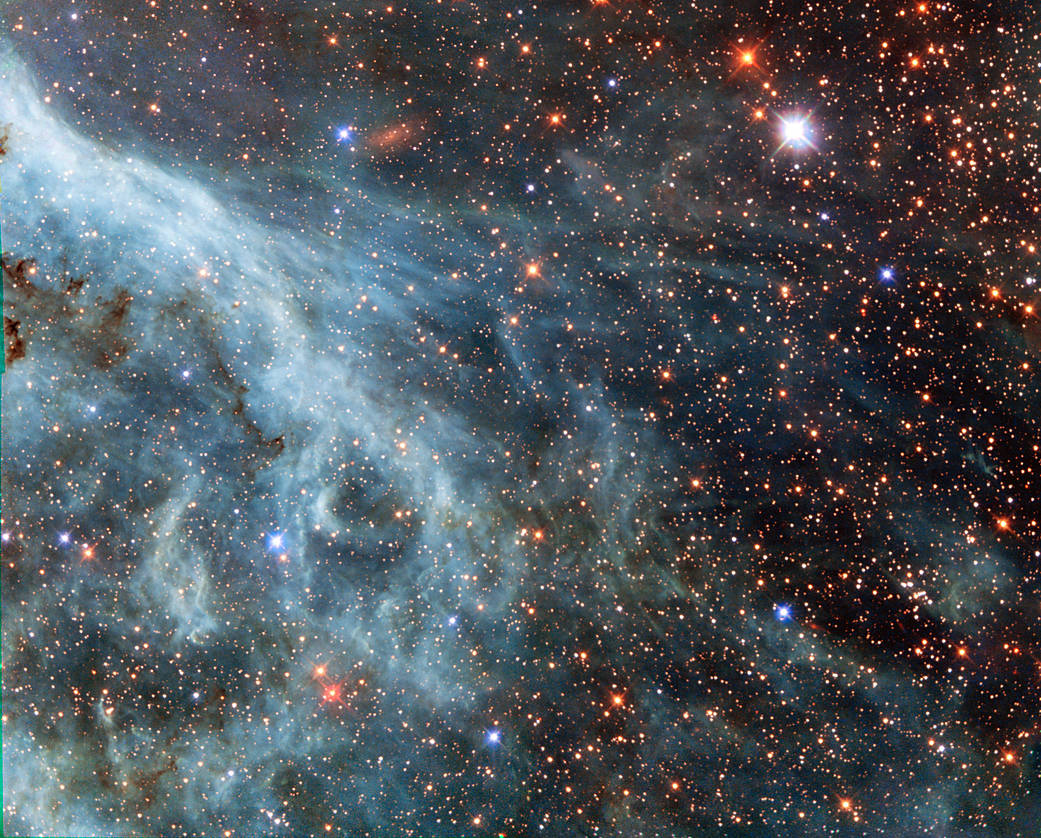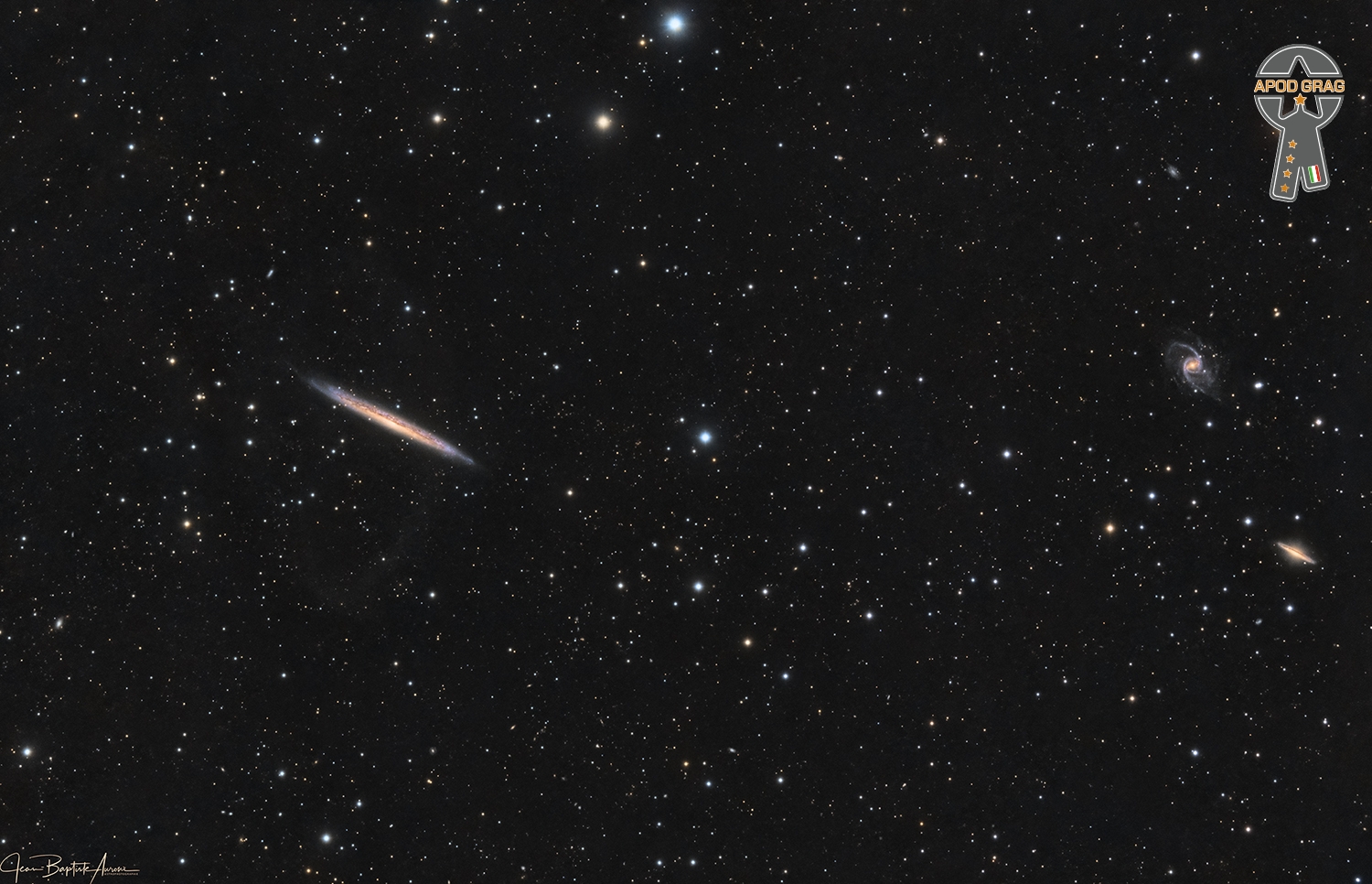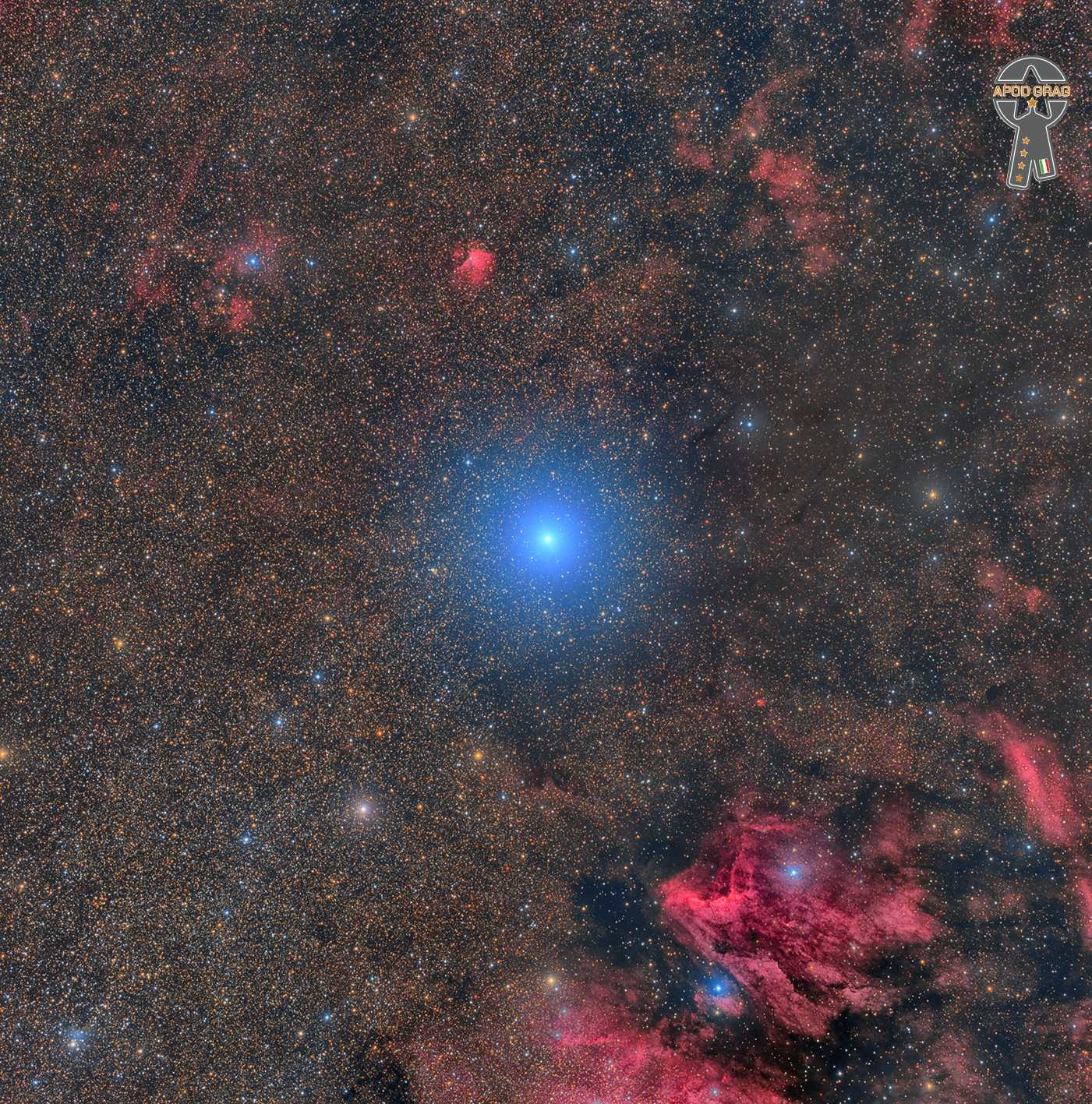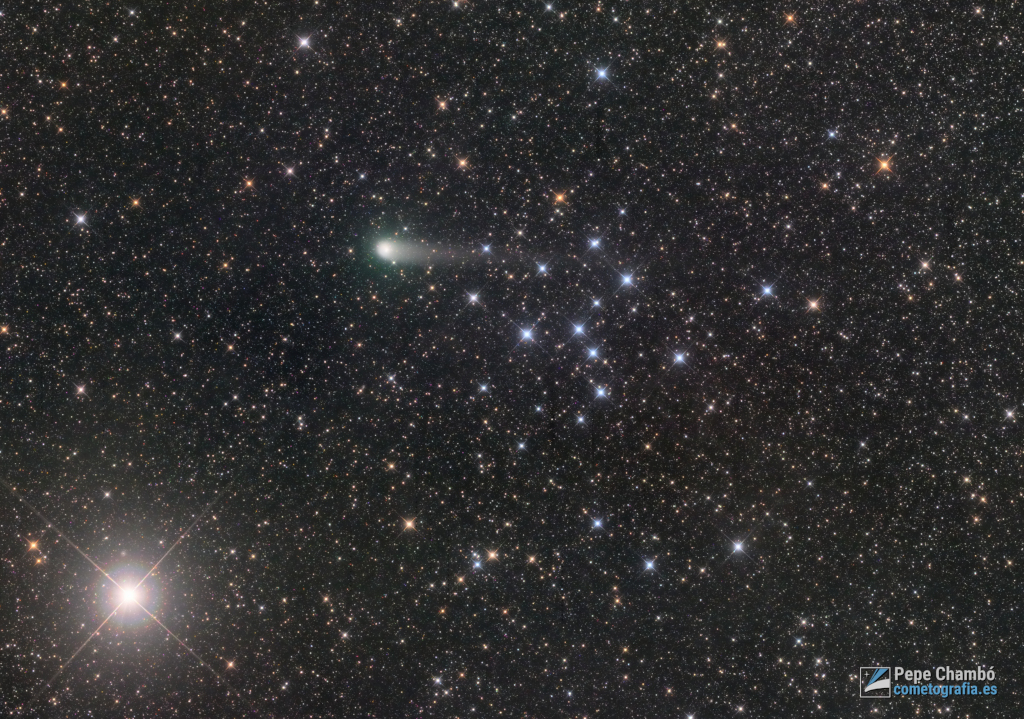Blog
The brightly glowing plumes seen in this image are reminiscent of an underwater scene, with turquoise-tinted currents and nebulous strands reaching out into the surroundings. However, this is no ocean. This image actually shows part of the Large Magellanic Cloud (LMC), a small nearby galaxy that orbits our galaxy, the Milky Way, and appears as a blurred blob in our skies. The NASA/ESA Hubble Space Telescope has peeked many times into this galaxy, releasing stunning images of the whirling clouds of gas and sparkling stars (opo9944a, heic1301, potw1408a). This image shows part of the Tarantula Nebula’s outskirts. This famously beautiful nebula, located within the LMC, is a frequent target for Hubble (heic1206, heic1402). In most images of the LMC the colour is completely different to that seen here. This is because, in this new image, a different set of filters was used. The customary R filter, which selects the red light, was replaced by a filter letting through the near-infrared light. In traditional images, the hydrogen gas appears pink because it shines most brightly in the red. Here however, other less prominent emission lines dominate in the blue and green filters. This data is part of the Archival Pure Parallel Project (APPP), a project that gathered together and processed over 1000 images taken using Hubble’s Wide Field Planetary Camera 2, obtained in parallel with other Hubble instruments. Much of the data in the project could be used to study a wide range of astronomical topics, including gravitational lensing and cosmic shear, exploring distant star-forming galaxies, supplementing observations in other wavelength ranges with optical data, and examining star populations from stellar heavyweights all the way down to solar-mass stars. A version of this image was entered into the Hubble’s Hidden Treasures image processing competition by contestant Josh Barrington.

Lonnie Smith (July 3, 1942 – September 28, 2021), styled Dr. Lonnie Smith, was an American jazz Hammond B3 organist who was a member of the George Benson quartet in the 1960s. He recorded albums with saxophonist Lou Donaldson for Blue Note before being signed as a solo act. He owned the label Pilgrimage, and was named the year’s best organist by the Jazz Journalists Association nine times.
Smith was born in Lackawanna, New York, on July 3, 1942. He was raised by his mother and stepfather, and the family had a vocal group and radio program. He stated that his mother was a major influence on him musically, as she introduced him to gospel, classical, and jazz music.
more...Rhoda Scott (born July 3, 1938) is an American soul jazz organist.
Scott was first attracted to the organ in her father’s church at age seven. “It’s really the most beautiful instrument in the world”, she stated in a 2002 interview. “The first thing I did was take my shoes off and work the pedals.” From then on she always played her church organ in her bare feet, and to this date she has continued the practice.
In 1967, Scott moved to France, where she has since spent most of her career.
more...John Coles (July 3, 1926 – December 21, 1997) was an American jazz trumpeter. Coles was born in Trenton, New Jersey on July 3, 1926. He grew up in Philadelphia and was self-taught on trumpet.
Coles spent his early career playing with R&B groups, including those of Eddie Vinson (1948–1951), Bull Moose Jackson (1952), and Earl Bostic(1955–1956). He was with James Moody from 1956 to 1958, and played with Gil Evans‘s orchestra between 1958 and 1964, including for the album Out of the Cool. After this he spent time with Charles Mingus in his sextet which also included Eric Dolphy, Clifford Jordan, Jaki Byard, and Dannie Richmond. Following this he played with Herbie Hancock (1968–1969), Ray Charles (1969–1971), Duke Ellington (1971–1974), Art Blakey (1976), Dameronia, Mingus Dynasty, and the Count Basie Orchestra under the direction of Thad Jones (1985–1986).
In 1985 Coles settled in the San Francisco Bay area; he recorded with Frank Morgan and Chico Freeman the following year. After his return to Philadelphia in 1989 he again worked with Morgan and was part of Gene Harris‘s Philip Morris Superband. In 1990 he recorded with Charles Earland and Buck Hill. Coles recorded as a leader several times over the course of his career. He died of cancer on December 21, 1997 in Philadelphia.
more...NGC 5907 also nicknamed the “Splinter Galaxy” is a spiral galaxy seen from the edge and located in the constellation of the Dragon at about 30 million light years from the Milky Way.
This galaxy has a huge but very faint trail of stars surrounding it. It is certainly the remains of a collision or an old merger of NGC 5907 with a dwarf galaxy.
More explanations here: https://www.cosmotography.com/images/small_ring_ngc5907.html
NGC 5905 and NGC 5908 (on the right) are much further away, about 150 million light-years…

July 2nd 1924 Silas McClatcher first started singing as a young teen with his identical twin brother, Paul (d. 2006), in Holly Spring, Mississippi. Silas moved to Chicago in 1965, to Milwaukee in 1975, and back to Chicago in 2011, always for better employment opportunities.
He continued to sing privately while hitting all of the clubs where the blues were hot, as he became known as ‘Slim’. One night Milwaukee’s Legendary Bluesman, ‘Stokes’, called Slim up to sing and it was from that point forward his singing became quick in demand, and he received his official blues name “Milwaukee Slim”.
Milwaukee Slim sat in regularly with Stokes and also with Gene and the Soul Gang as they toured all over WI. He has established a rich resume which includes opening shows in WI for Koko Taylor, John Lee Hooker, and Phillip Walker. Milwaukee Slim performed for the Green Bay Packers (2000), and has performed at many WI and IL Festivals over the years, including WI State Fair (1998 – 2004), Shermanfest, and The Chicago Blues Festival. He has been a member of the Midwest Blues All Stars, The House Rockin Blues Review and his own Milwaukee Slim Band. He has performed with the Hayes Family Blues Band, and recorded with Hubert Sumlin, Billy Flynn, Piano Willie, Jim Liban, Barrelhouse Chuck, Calvin Jones, Smokey Smothers, Kent “The Colonel” Knapp, Barefoot Jimmy, Richard Raven, Leroy Airmaster, The Legendary Blues Band, Little Charlie and the Nightcats. and Shoji Naito.
Milwaukee Slim is one of three featured artists that have just finished recording with Rockin’ Johnny (guitar), Steve Dougherty (drums), John Sefner (bass), Illinois Slim (rhythm guitar), and Mike Mettalia (harmonica) for an album to be released in 2017. You can find Milwaukee Slim performing anywhere between Milwaukee and Chicago as he remains a fan favorite!
more...Ahmad Jamal (born Frederick Russell Jones, July 2, 1930) is an American jazz pianist, composer, bandleader and educator. For six decades, he has been one of the most successful small-group leaders in jazz.
Jamal was born Frederick Russell Jones in Pittsburgh, Pennsylvania, on July 2, 1930. He began playing piano at the age of three, when his uncle Lawrence challenged him to duplicate what he was doing on the piano. Jamal began formal piano training at the age of seven with Mary Cardwell Dawson, whom he describes as greatly influencing him. His Pittsburgh roots have remained an important part of his identity (“Pittsburgh meant everything to me and it still does,” he said in 2001) and it was there that he was immersed in the influence of jazz artists such as Earl Hines, Billy Strayhorn, Mary Lou Williams, and Erroll Garner. Jamal also studied with pianist James Miller and began playing piano professionally at the age of fourteen, at which point he was recognized as a “coming great” by the pianist Art Tatum. When asked about his practice habits by a critic from The New York Times, Jamal commented that, “I used to practice and practice with the door open, hoping someone would come by and discover me. I was never the practitioner in the sense of twelve hours a day, but I always thought about music. I think about music all the time.”
more...Imam Mohammad Ahmad Eissa (July 2, 1918 – June 6, 1995 ) was a famous Egyptian composer and singer. For most of his life, he formed a duo with the famous Egyptian colloquial poet Ahmed Fouad Negm. Together, they were known for their political songs in favor of the poor and the working classes.
Imam was born to a poor family in the Egyptian village of Abul Numrus in Giza. He lost his sight when he was a child. At the age of five he joined a recitation class, where he memorized the Qur’an. He later moved to Cairo to study where he led a dervish life. In Cairo, Imam met Sheikh Darwish el-Hareery, a prominent musical figure at that time, who taught him the basics of music and muwashshah singing. He then worked with the Egyptian composer Zakariyya Ahmad. At that time, he expressed interest in Egyptian folk songs especially those by Sayed Darwish and Abdou el-Hamouly. He also performed at weddings and birthdays.
more...Deneb is a first-magnitude star in the constellation of Cygnus, the swan. It is one of the vertices of the asterism known as the Summer Triangle and the “head” of the Northern Cross. It is the brightest star in Cygnus and the 19th brightest star in the night sky, with an average apparent magnitude of +1.25. This area lies in the plane of the Milky Way and is very rich in emission nebulae. Right down you can see NGC 7000/The North America Nebula, IC 5067/The Pelican Nebula, NGC 6989 an open cluster, 57 Cygni, IC 5068. Just a bit below left to Deneb is 55 Cygni and at the bottom left is IC 5076.
Deneb (/ˈdɛnɛb/) is a first-magnitude star in the constellation of Cygnus, the swan. Deneb is one of the vertices of the asterism known as the Summer Triangle and the “head” of the Northern Cross. It is the brightest star in Cygnus and the 19th brightest star in the night sky, with an average apparent magnitude of +1.25. A blue-white supergiant, Deneb rivals Rigel as the most luminous first-magnitude star. However, its distance, and hence luminosity, is poorly known; its luminosity is somewhere between 55,000 and 196,000 times that of the Sun. Its Bayer designation is α Cygni, which is Latinised to Alpha Cygni, abbreviated to Alpha Cyg or α Cyg.

more...
Leon “Ndugu” Chancler (/ɪnˈduːɡuː ˈtʃænslər/ in-DOO-goo CHANSS-lər; July 1, 1952 – February 3, 2018) was an American pop, funk and jazz drummer. He was also a composer, producer, and university professor.
Born in Shreveport, Louisiana, on July 1, 1952, Leon Ndugu Chancler was the last child of seven children from the union of Rosie Lee and Henry Nathaniel Chancler. In 1960 the family relocated to Los Angeles, California. Chancler began playing drums when he was thirteen years old. He would publicly reminisce about being asked to leave a classroom for continuously tapping on the desk, only to be later heard tapping on the poles in the hallway. His love for the drums took over while attending Gompers Junior High School and it became his lifelong ambition. He graduated from Locke High School having been heavily involved in playing there with Willie Bobo and the Harold Johnson Sextet. He graduated from California State University, Dominguez Hills with a degree in music education. By then he had already performed with the Gerald Wilson Big Band, Herbie Hancock, and recorded with Miles Davis, Freddie Hubbard, and Bobby Hutcherson.
He recorded as a sideman in jazz, blues, and pop music, including instantly recognizable drums on “Billie Jean” by Michael Jackson. In 1982, he received a Grammy nomination for Best Rhythm & Blues song, for co-writing “Let It Whip” made famous by the Dazz Band. He worked with George Benson, Stanley Clarke, The Crusaders, George Duke, Herbie Hancock, John Lee Hooker, Michael Jackson, Hubert Laws, Thelonious Monk, Jean-Luc Ponty, Lionel Richie, Kenny Rogers, Patrice Rushen, Santana, Frank Sinatra, Donna Summer, The Temptations, Tina Turner, and Weather Report.
more...Rashied Ali, born Robert Patterson (July 1, 1933 – August 12, 2009) was an American free jazz and avant-garde drummer best known for playing with John Coltrane in the last years of Coltrane’s life.
Patterson was born and raised in Philadelphia, Pennsylvania. His family was musical; his mother sang with Jimmie Lunceford. His brother, Muhammad Ali, is also a drummer, who played with Albert Ayler. Ali, his brother, and his father converted to Islam.
Starting off as a pianist he eventually took up the drums, via trumpet and trombone. He joined the United States Army and played with military bands during the Korean War. After his military service, he returned home and studied with Philly Joe Jones, then toured with Sonny Rollins.
more...James Henry Cotton (July 1, 1935 – March 16, 2017) was an American blues harmonica player, singer and songwriter, who performed and recorded with many of the great blues artists of his time and with his own band. He played drums early in his career but is famous for his harmonica playing.
Cotton began his professional career playing the blues harp in Howlin’ Wolf‘s band in the early 1950s. He made his first recordings in Memphis for Sun Records, under the direction of Sam Phillips. In 1955, he was recruited by Muddy Waters to come to Chicago and join his band. Cotton became Waters’s bandleader and stayed with the group until 1965. In 1965 he formed the Jimmy Cotton Blues Quartet, with Otis Spann on piano, to record between gigs with the Muddy Waters band. He eventually left to form his own full-time touring group. His first full album, on Verve Records, was produced by the guitarist Mike Bloomfield and the singer and songwriter Nick Gravenites, who later were members of the band Electric Flag.
In the 1970s, Cotton played harmonica on Muddy Waters’ Grammy Award–winning 1977 album Hard Again, produced by Johnny Winter.
Cotton was born in Tunica, Mississippi. He became interested in music when he first heard Sonny Boy Williamson II on the radio. He left home with his uncle and moved to West Helena, Arkansas, finding Williamson there. For many years Cotton claimed that he told Williamson that he was an orphan and that Williamson took him in and raised him, a story he admitted in recent years is not true. However, Williamson did mentor Cotton during his early years. Williamson left the South to live with his estranged wife in Milwaukee, Wisconsin, leaving his band in Cotton’s hands. Cotton was quoted as saying, “He just gave it to me. But I couldn’t hold it together ’cause I was too young and crazy in those days an’ everybody in the band was grown men, so much older than me.
https://www.youtube.com/watch?v=YAqTrbuxCRI
more...William James Dixon (July 1, 1915 – January 29, 1992) was an American blues musician, vocalist, songwriter, arranger and record producer. He was proficient in playing both the upright bass and the guitar, and sang with a distinctive voice, but he is perhaps best known as one of the most prolific songwriters of his time. Next to Muddy Waters, Dixon is recognized as the most influential person in shaping the post–World War II sound of the Chicago blues.
Dixon’s songs have been recorded by countless musicians in many genres as well as by various ensembles in which he participated. A short list of his most famous compositions includes “Hoochie Coochie Man“, “I Just Want to Make Love to You“, “Little Red Rooster“, “My Babe“, “Spoonful“, and “You Can’t Judge a Book by the Cover“. These songs were written during the peak years of Chess Records, from 1950 to 1965, and were performed by Muddy Waters, Howlin’ Wolf, Little Walter, and Bo Diddley; they influenced a generation of musicians worldwide.
Dixon was an important link between the blues and rock and roll, working with Chuck Berry and Bo Diddley in the late 1950s. In the 1960s, his songs were adapted by numerous rock artists. He received a Grammy Award and was inducted into the Blues Hall of Fame, the Rock and Roll Hall of Fame, and the Songwriters Hall of Fame.
Dixon was born in Vicksburg, Mississippi, on July 1, 1915. He was one of fourteen children. His mother, Daisy, often rhymed things she said, a habit her son imitated. At the age of seven, young Dixon became an admirer of a band that featured pianist Little Brother Montgomery. He sang his first song at Springfield Baptist Church at the age of four. Dixon was first introduced to blues when he served time on prison farms in Mississippi as a young teenager. Later in his teens, he learned to sing harmony from a local carpenter, Theo Phelps, who led a gospel quintet, the Union Jubilee Singers, in which Dixon sang bass; the group regularly performed on the Vicksburg radio station WQBC. He began adapting his poems into songs and even sold some to local music groups.
more...Martinetes are a flamenco palo belonging to the group of the tonás or cantes a palo seco. As the rest of the songs in this group, it is sung with no accompaniment. In some dance shows for the stage, though, it is accompanied by percussion played with the compás of siguiriya. The percussion instruments chosen for this are frequently a hammer and anvil, to evocate the origins of this palo, attributed to Gypsy smiths. It is not probable, though, that they were real work songs: they demand too much effort and faculties to be sung while carrying out a heavy task like that of a smith. They were more probably sung in family gatherings.
Although martinetes are often classified under the toná group on the grounds that they share its a cappella nature, the melody types differ strongly from the rest of tonás, so it is now generally considered to be a different palo. A characteristic that differentiates them from the tonás, normally in major mode, is their modulating character, constantly going from major to phrygian mode.
The stanza of the martinete is the cuarteta romanceada: four eight-syllable lines, rhyming in assonance abcb. The subject matters often contain allusions to persecution, prison, and the environment of the forges.
Carceleras are usually considered a subclassification of martinetes, with prison as the subject matter of their lyrics. The debla, a rather rare style, is considered by some flamenco fans as a type of martinete, while other consider it as a palo on its own.
more...Imaged on June 20 2022, comet C/2017 K2 (PanSTARRS) shares this wide telescopic field of view with open star cluster IC 4665 and bright star Beta Ophiuchi, near a starry edge of the Milky Way. On its maiden voyage to the inner Solar System from the dim and distant Oort cloud, this comet PanSTARRS was initially spotted over five years ago, in May 2017. Then it was the most distant active inbound comet ever found, discovered when it was some 2.4 billion kilometers from the Sun. That put it between the orbital distances of Uranus and Saturn. Hubble Space Telescope observations indicated the comet had a large nucleus less than 18 kilometers in diameter. Now visible in small telescopes C/2017 K2 will make its closest approach to planet Earth on July 14 and closest approach to the Sun this December. Its extended coma and developing tail are seen here at a distance of some 290 million kilometers, a mere 16 light-minutes away.

More Posts
- Esther Phillips
- Alberto Hemsi
- Frank Morgan
- Chet Baker
- World Music The Bothy Band
- Daily Roots Carlene Davis & Naomi Cowan
- Cosmos NGC 1360
- Lil Green
- John Patitucci
- Ronnie Ball
- World Music Parisa Pouladian
- Daily Roots Mickey Simpson
- Happy Winter Solstice 2024
- Cosmos Sh2-106
- John Hicks
- Harmonica Slim
- Paco de Lucía
- Frank Zappa
- Hank Crawford
- World Music Fabio Bergamini